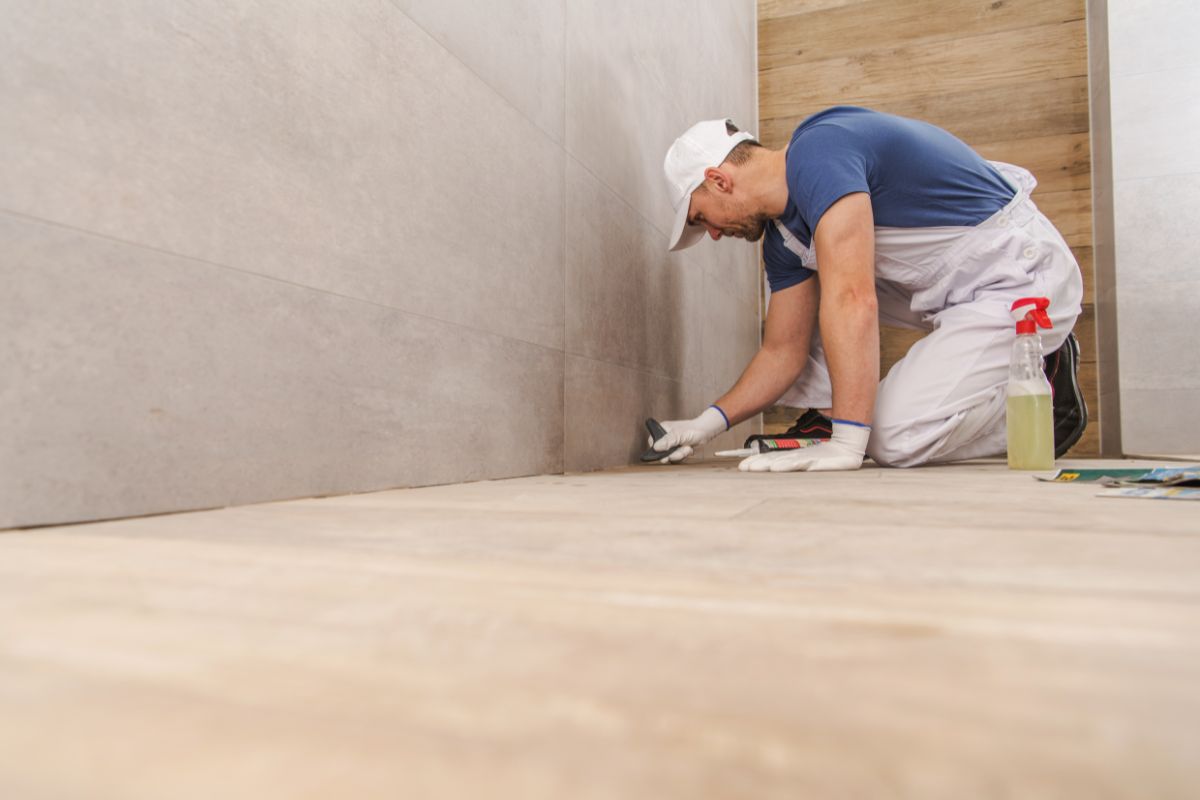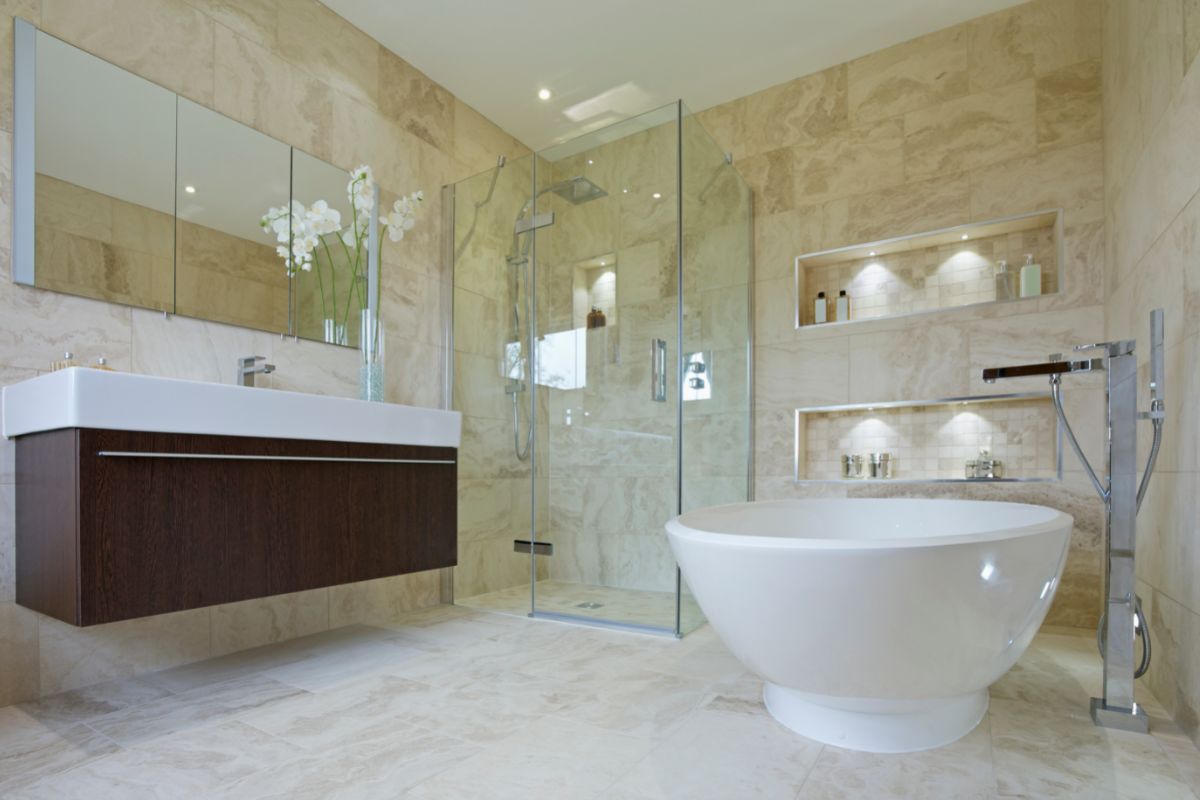When you ask anyone what the most important room in a home is, they’ll probably either say the living room, the kitchen, or the bedroom.
After all, the living room is a central, social living space, the kitchen is where you prepare food for sustenance, and the bedroom is where you get sleep, which is essential to physical and mental wellbeing.

However, we believe that the bathroom is much more important than people give it credit for.
We all use and rely on the bathroom every day, even if we don’t really think about it, and the number of bathrooms in a home can either be a massive selling point or a letdown for potential buyers.
Unfortunately, in addition to being one of the most important rooms in any home, the bathroom is notoriously difficult to furnish.
Unlike other rooms in your home, you can’t just go with what you think will look the best.
You need to consider how certain materials will respond to water (spillages, overflows and leaks happen!) including condensation.
This is especially true when it comes to the flooring you select for your bathroom.
In this guide, we’ll be helping you to choose the best flooring for your bathroom, covering all the dos and don’ts of selecting bathroom flooring and the best options for a comfortable, waterproof bathroom.
The Necessity Of Waterproof Flooring For Bathrooms
As we just mentioned, the main thing you need to consider when choosing flooring for your bathroom is waterproofing.
Notice that we said waterproof and not ‘water-resistant’. There is a very important difference.
Many flooring options are described as water-resistant, and this means that they are able to resist being penetrated by water.
However, over time, water-resistant flooring will end up getting soaked through by moisture if you install it in a bathroom, leading to damage to the flooring itself as well as other arguably worse problems.
If you’re looking to install flooring in your kitchen, for example, water-resistant options are fine.
Sure, your kitchen floor will have some exposure to water, but it won’t come up against nearly the same levels of exposure as bathroom flooring.
This is why you’ll often see kitchen flooring options made with porous materials such as plywood.
But these materials would not fare well in a bathroom environment – eventually, they will peel, warp, and swell until they need replacing altogether.
Unlike water-resistant flooring, waterproof flooring doesn’t simply resist water – it’s totally impervious to it.
If you have waterproof flooring in your bathroom, rest assured that you could leave a puddle of water sitting on your floor for hours or even days without it penetrating the material and getting to the subflooring.
This not only ensures the durability of your flooring, but it also ensures that you won’t have to deal with mold damage at a later date from moisture accumulation underneath your floor.
So, when you’re choosing flooring for your bathroom, please choose waterproof flooring over water-resistant options.
Sometimes, this may mean spending a little more, but it’s worth it when you consider the fact that water-damaged flooring usually can’t be repaired and will need replacing completely on top of mold treatment expenses.
We’ll be discussing the best waterproof materials for bathroom flooring a little later in this article, but first, we’re going to talk about some options you should definitely avoid.
Bathroom Flooring To Avoid
The aim of this guide is to inform you about the best possible materials for bathroom flooring.
However, sometimes it’s even more important to know what not to do so you can avoid big problems down the line.
Here are some materials you should steer clear of when it comes to your bathroom flooring:
Hardwood Floor
Hardwood floors are popular for home decor, and you can use this type of flooring in virtually any room in your house – just not the bathroom.
While hardwood flooring is certainly durable in terms of its strength and also has a very appealing classic look, sealing a hardwood floor to make it totally waterproof is extremely difficult.
You would need to do it absolutely perfectly to prevent even the tiniest bit of moisture from seeping through and causing wood rot.
Even if you did manage to seal your hardwood flooring entirely, you’d need to re-seal it on a regular basis using polyurethane, so you would end up with a very high-maintenance bathroom floor that could be vulnerable to rot with even the slightest oversight.
Carpet
We get it – when you walk into the bathroom to brush your teeth first thing in the morning, it’s nice to feel soft warmth on the soles of your feet rather than cold, hard tiles.
Unfortunately, though, installing carpet on your bathroom floor is a recipe for disaster when it comes to mold issues.
Carpeted bathrooms were very popular in the 70s and 80s, but the initial luxury of having warm feet in the bathroom came at a significant cost.
As you can imagine, the fabric of carpet soaks up all the moisture it comes into contact with, whether that’s overspray from the taps or condensation in the air.
This turns into mildew and mold, which not only cause damage to your subflooring but may also result in health issues for those using the bathroom regularly.
Additionally, moist carpeting is a breeding ground for bacteria and germs, which is the last thing you want to expose your bare feet to.
And if you’ve ever used a bathroom with a tiled floor, you’ll know how often it needs cleaning to keep it from looking dirty.
Imagine all that dirt hidden between carpet fibers. No thanks!
Laminate Flooring
Laminate flooring is an inexpensive flooring option that is popular throughout various home spaces, from kitchens to bedrooms.
These engineered woods have a top layer made of real wood, so you might assume that this would be a good choice for waterproof bathroom flooring.
Unfortunately, the top layer often isn’t sealed tightly enough to prevent moisture from getting through to the materials underneath, which typically aren’t water-resistant, let alone waterproof.
This means that laminate flooring installed in a bathroom is prone to warping and swelling unless any moisture is cleared up immediately (which is much easier said than done when you consider factors like condensation in the air).
So, laminate flooring really isn’t the best choice for your bathroom.
The Best Options For Bathroom Flooring
Now that we’ve focused on the negatives and covered all the types of flooring you should never put in your bathroom, let’s lighten up a little and talk about some of the best options for bathroom floors.
These include:
Natural Stone Tiling

Not only does natural stone tile add a natural, rustic beauty to any room, this type of tiling is the perfect choice for a bathroom.
Natural stone tile flooring is wear-resistant and comes in a wide range of patterns and colors.
You can choose different types of natural stone for your bathroom floor, ranging from limestone to marble, and you also have the choice of buying it in pre-cut planks, tiles, or mosaics.
Most importantly, it is completely waterproof, so you won’t have to worry about mold and mildew.
Admittedly, natural stone tiling is a costly option (after all, it’s not artificially manufactured, so it’s a limited resource), so it won’t be a realistic choice for everyone.
However, if you have the budget to invest in a high-end finish for your bathroom floor, it’s an excellent choice.
Bear in mind that installing natural stone tiling can be difficult if you’re doing it as a DIY project. If you have the means, consider hiring a professional to help.
It’s also important to remember that stone tiling has the drawback of being slippery underfoot.
Because of this, you will want to apply grout patterns or a rough finish to the tile to make sure no accidents happen.
Porcelain Or Ceramic Tiling
If you have your heart set on a tiled floor for your bathroom but don’t have the budget for natural stone, porcelain or ceramic tile is a more affordable option.
Porcelain or ceramic tiling is wear-resistant and durable as well as waterproof, so once you have it installed, it’s there to stay for a long time.
Additionally, this type of tiling is very flexible from an aesthetic standpoint because it’s available to purchase in various patterns and colors.
Some people are hesitant to choose ceramic or porcelain tiling for their bathroom flooring because it feels cold and hard underfoot, but if that really bothers you, ceramic and porcelain tiles can be installed alongside a radiant flooring system so your feet won’t get too cold in the winter months.
Crucially, this type of tiling is very sterile, so you won’t have to worry as much about hygiene issues as you would with porous or absorbent materials.
Stained Concrete
You might never have considered concrete flooring for your bathroom floor since most people’s first image of a concrete floor is an unfinished, gray slab.
However, stained concrete is a great choice for bathroom flooring as long as it is properly sealed and finished.
Sealed and finished concrete is waterproof (but you’ll have to make sure there are no gaps whatsoever in the sealing to avoid water getting into the concrete itself.
This type of flooring is very durable and affordable, and with the right staining, concrete can look absolutely stunning in a bathroom.
Just look up some images of stained concrete bathroom floors and see for yourself!
Just bear in mind that concrete can be slippery when it gets wet, so a non-slip additive will be required if you want to ensure the safety of everyone using your bathroom.
Waterproof Vinyl
If you’re looking for a budget-friendly option for your bathroom flooring, consider waterproof vinyl!
This is an umbrella term for various types of flooring, ranging from SPC vinyl to WPC vinyl.
You can find waterproof vinyl flooring that replicates the look and feel of other materials, ranging from ceramic tile to stone and wood.
Waterproof vinyl flooring is durable, particularly when it comes to scratch-resistance, and since it’s totally waterproof, you don’t have to worry about whether the flooring will get moldy after exposure to moisture.
Frequently Asked Questions
What Is The Best Floor For A Small Bathroom?
If you’re installing flooring in a small bathroom, we recommend going for a more high-end option.
Since you have a smaller floor area to work with, you may be able to opt for a more expensive material like natural stone or ceramic tile as opposed to vinyl flooring or concrete since you won’t have to pay for as much of the material.
What Is The Easiest Bathroom Flooring To Install?
The easiest installation when it comes to bathroom flooring will probably be vinyl tile since you can usually order this in a sheet that you can cut to size and stick down without too much effort.
Is Vinyl Or Laminate Better For Bathroom Floors?
If you’re choosing between laminate and vinyl for your bathroom floor, always go with the vinyl.
Laminate flooring isn’t usually waterproof and the materials under the top layer often aren’t even water-resistant, so you may end up with mold problems, which isn’t likely when you choose vinyl flooring instead.
Plus, vinyl flooring is more budget-friendly, so it’s generally a better option on all counts.
Final Thoughts
The best flooring materials for bathroom floors are waterproof vinyl, ceramic or porcelain tiles, natural stone tiles, or stained concrete.
These materials are all durable and waterproof, and vinyl and concrete are especially budget-friendly.
On the other hand, you definitely want to avoid laminate flooring, carpet, and hardwood for your bathroom floor since all these materials are either porous or absorbent so you will end up with swelling, warping, and mold problems.
Carpet is an especially bad choice because it also provides an optimal space for bacteria to multiply, so whatever you do, don’t put down carpet in your bathroom!
Remember, if you’re installing a trickier flooring material like natural stone tile, don’t be afraid to seek professional assistance.
- How To Drill Into Brick? - October 31, 2022
- How To Repair And Refinish Hardwood? - October 31, 2022
- Floetrol – What Is It? When To Use It: Complete Guide - October 31, 2022
